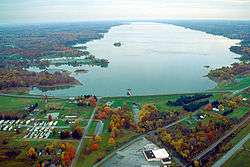Mosquito Creek Lake
Mosquito Creek Lake (formerly Mosquito Creek Reservoir) is a reservoir in Trumbull County, northeast Ohio, in the United States. It is approximately 6 mi northeast of Warren. It is fed by Mosquito Creek and Walnut Creek.[3] Construction was completed in 1944.[4]
| Mosquito Creek Lake | |
|---|---|
 | |
 Mosquito Creek Lake | |
| Location | Trumbull County, Ohio, US |
| Coordinates | 41°22′16″N 80°45′18″W[1] |
| Type | Reservoir |
| Primary inflows | Mosquito Creek |
| Primary outflows | Mosquito Creek |
| Basin countries | United States |
| Max. length | 9.5 mi (15.3 km)[2] |
| Max. width | 0.75 mi (1.21 km)[2] |
| Surface area | 7,850 acres (3,180 ha)[2] |
| Max. depth | 25 ft (7.6 m)[2] |
| Surface elevation | 899 ft (274 m)[1] |
| References | [1] |
Description
Mosquito Creek Lake is a man-made reservoir. It is the second-largest inland lake in Ohio.[5] Depth averages 8 to 15 feet (depending on season), but the southern end, towards the dam, averages 20 to 25 feet (6.1 to 7.6 m). The northern end is considerably more shallow, with depths averaging only 4 to 10 feet.[2] Completely surrounding the lake is Mosquito Lake State Park.[2] The lake is bisected by the Ohio State Route 88 causeway.[2] The drainage area for lake is 97.4 square miles (252 km2).[4]
History
Initial plans for Mosquito Creek Reservoir were developed in the 1930s.[6] The reservoir was authorized by the Flood Control Act of 1938 and it was constructed as a means for flood control[5] and the regulation of streamflow.[4] Construction of the dam that created the lake was completed by the U.S. Army Corps of Engineers in April, 1944.[6] The reservoir provides flood protection for the upper Ohio River, Beaver river and the Mahoning River valley.[5] Additional benefits contemplated were reduction in pollution from local steel processing, and the provision of water supply to the city of Warren.[6] In 1971 the Board on Geographic Names Decisions officially changed the name from Mosquito Creek Reservoir to Mosquito Creek Lake.[1]
Recreation
The lake is surrounded by Mosquito Lake State Park, operated by the Ohio Department of Natural Resources. There are picnicking and camping, as well as designated hiking trails. Opportunities for water recreation are provided, including dock rentals, boat ramps, and various watercraft rentals.[7] Fishing for flathead catfish is highly recommended at the location. Other species recreationally fished in the lake are bluegill, channel catfish, crappie, largemouth bass, northern pike, ring perch, and walleye.[2]
Ecological issues
The north part of the lake is a designated refuge for waterfowl. Boating and fishing are prohibited in these areas.[2] There has been concern that the Asian carp will reach Lake Erie via Mosquito Creek Reservoir, but the probability of this occurrence has been deemed low.[8] Invasive Zebra mussels have proliferated in the lake. This causes the lake's water to be more transpicuous than normal, and subsequently water-plants thrive in the ecosystem.[2] Soon after construction the lake's water was considered among the best in the area,[4] but man-made pollution from nearby residential areas has been a concern.[3]
References
- "Mosquito Creek Lake". Geographic Names Information System. United States Geological Survey. July 12, 1979. Retrieved April 2, 2015.
- Cross, Tom (2008). Fishing Ohio: An Angler's Guide to Over 200 Fishing Spots in the Buckeye State. Globe Pequot. pp. 164–168. ISBN 9780762743261.
- "More fluid spotted in Cortland creek". WKBN. Youngstown, Ohio. March 15, 2015. Retrieved April 2, 2015.
- Cross, W. P.; Schroeder, M. E.; Norris, S. E. (1952). "Water Resources of the Mahoning River Basin, Ohio". United States Geological Survey. Washington D.C.: United States Department of the Interior (177): 7, 21.
- Mosquito Creek Lake, US Army Corps of Engineers, retrieved 8 April 2015
- "History and Natural Features". Ohio State Parks. Ohio Division of Natural Resources. Retrieved April 7, 2015.
- "Activities". Ohio State Parks. Ohio Division of Natural Resources. Retrieved April 7, 2015.
- Egan, D'Arcy (February 26, 2013). "Asian carp DNA found around the Great Lakes, but the invasive fish have yet to be captured". Cleveland Plain Dealer. Retrieved April 2, 2015.